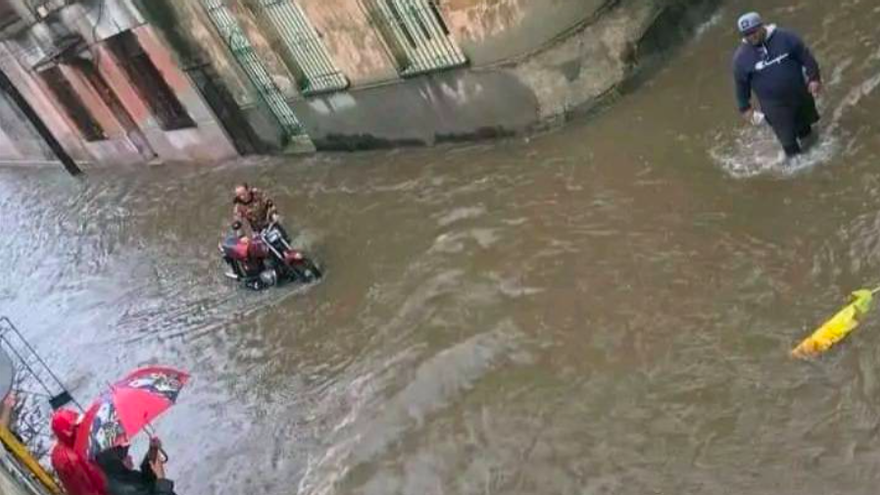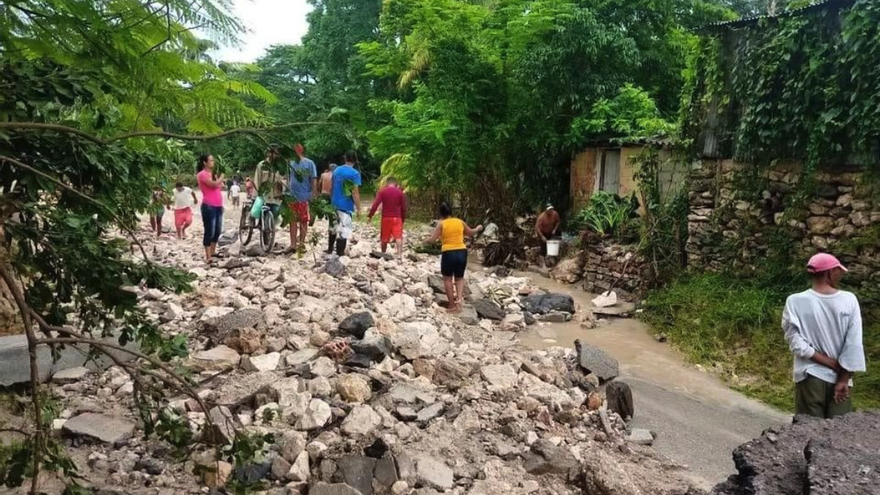
![]() 14ymedio, Havana, 9 June 2023 — A 60-year-old man from Jiguaní, Granma, who was not identified by the local press, is the first to die during the floods that have affected the Cuban east in recent days. The victim died “by drowning,” CNC TV said in a report about the damage caused by the rains.
14ymedio, Havana, 9 June 2023 — A 60-year-old man from Jiguaní, Granma, who was not identified by the local press, is the first to die during the floods that have affected the Cuban east in recent days. The victim died “by drowning,” CNC TV said in a report about the damage caused by the rains.
Neither the official press nor the national leaders seem too alarmed by the floods. A different panorama shows the photographs that, from different towns, indicate the urgency of taking quick measures to contain the damage and prevent more human lives from being lost.
Only in the provincial newspapers is there concern for a reality to which, as has happened in other times of crisis, the authorities react too late. Inertia and clumsiness in management also seem to mark the road map in the face of this week’s rains.
The local newspaper of Granma, La Demajagua, pointed out “damage from the floods” that the local authorities were engaged in “evaluating.” Jiguaní presents, according to the newspaper, a “very tense” situation after the “overflow of the riverbed,” which caused a stampede of the inhabitants of the area at 3:00 in the morning.
The town also does not have electricity, “because the cables are down,” and the road that leads to the town of Dos Ríos is also flooded by the Contramaestre River. Throughout the province there is “severe damage to homes, bridges and other roads, as well as to agriculture.”
In the town of Contramaestre itself, the Sierra Maestra reported that “the rainfall has been strong and locally intense, with an accumulation at the end of the morning of 7 inches, the highest figure of the year.” The towns of Bartolomé Masó, with 14 inches, and Minas de Charco Redondo, with 11, “unprecedented figures” as the media pointed out, also broke records.

This Thursday, 14ymedio learned about the emergency due to the lack of supplies in the eastern territory. “No one can go out to look for food,” Walfrido Rojas, a resident of Dos Ríos, said by phone. “At least we had a little corn flour stored, but in our neighborhood there are people who no longer have anything to eat.”
“All the rivers of Camagüey are overflowing; water has reached parts of the city where no one remembers floods of this type,” Rosalía, a 68-year-old woman from Camagüey, tells 14ymedio by phone. “We are without electricity, and it hasn’t stopped raining since last night. Our house is made of wood, which gives us some calm, but in the neighborhood where we live, near the train terminal, numerous houses are having problems with their tile roofs.”
“People were taken by surprise because there was talk of rain but what has happened is worse than in some of the last hurricanes that we remember. Nobody was prepared for what was coming, so this has caught us totally without reserves.”
“You can’t go out; there are neighborhoods where the streets are rivers, and there are also problems communicating by phone,” Rosalía explains.
#LluviasEnElOrienteCubano "A la calle no se puede salir, hay repartos donde las calles son ríos", cuenta a '14ymedio', vía telefónica, Rosalía, una camagüeyana de 68 años | Video: ArqJulioHerrera/Twitter👉🏼 https://t.co/thLnDh156J pic.twitter.com/9FdjkIcGiR
— 14ymedio (@14ymedio) June 9, 2023
As reported on social networks by independent journalist José Luis Tan Estrada, in Camagüey “the water reaches Pobre Street in the city. In addition, there are flood reports in several neighborhoods: Vista Hermosa, Piña, El Jardín, Saratoga, La Guernica, Salomé, La Mosca, Montecarlo, Jayamá, El Retiro and other lowlands.”
In addition, he complained about the existence of “dirty sewers and storm drains,” “houses in danger of collapse” and “several areas without electricity.” At 8:00 a.m. this Friday, he said, the level of rainfall in the province had reached 4 inches of water.
The accumulated rainfall in Las Tunas was 72 inches on Thursday night. The most affected communities have been those of Jesús Menéndez, Jobabo and Manatí, in addition to the provincial capital. “The rains continue! Stay alert,” the local press warned. Pessimistic, the article says not to rejoice too much over the “relief” of having filled the reservoirs, since the weather left “uncovered debts accumulated for years and effects on homes and infrastructure” throughout the territory.
Granma did not see too many reasons to worry, but emphasized, as one of its articles this Friday states, that “the waters have been good for the reservoirs.” The newspaper barely translates the damage into figures, which refer only and broadly to how many inhabitants were evacuated in each town.
Only when referring to Camagüey does the article acquire a realistic tone: “The largest amount of damage is reported in 64 homes, of which 41 partially lost the roof and 14 totally. Eight buildings completely collapsed and one partially collapsed. An elderly person was injured when the roof of his house, located in the historic center of the city, fell while he was trying to repair it, but his state of health is stable and his injuries are not life-threatening.”
This Wednesday, the Institute of Meteorology of Cuba issued a special notice, explaining that the cause of the heavy downpours is the combination of a trough in the middle and high levels of the troposphere over the Gulf of Mexico, along with a humid flow from the south in the low levels, to which is added the evening instability.
More accurate than the press, but with great discretion, the Cuban Meteorological Radars have shown the satellite diagrams that give the evolution of the rains: a compact mass, which resists leaving the Cuban east, occupies the center of the map.
Translated by Regina Anavy
____________
COLLABORATE WITH OUR WORK: The 14ymedio team is committed to practicing serious journalism that reflects Cuba’s reality in all its depth. Thank you for joining us on this long journey. We invite you to continue supporting us by becoming a member of 14ymedio now. Together we can continue transforming journalism in Cuba.
